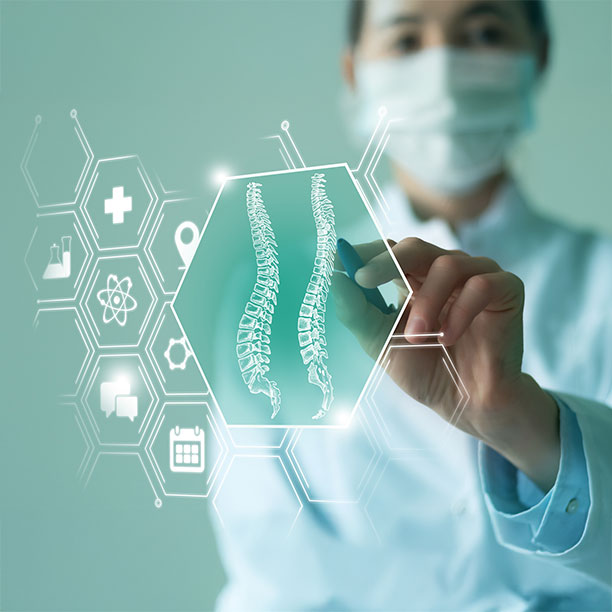Idiopathic scoliosis
Idiopathics scoliosis is a three-dimensional structural deformity of the spine that appears in children as they grow. Once it has appeared, nothing can erase it, and those who suffer from it are likely to suffer its more or less severe consequences for the rest of their lives :
A structural deformation of spinal components
(vertebrae, discs, ligaments), as opposed to scoliotic attitudes, which are simple reactionary curvatures to rebalance the normal spine and are always reversible.
A three-dimensional deformation
because scoliosis is not just a classic lateral deviation, but a much more complex deformity, involving rotation of the vertebrae and disruption of the physiological sagittal curvatures, and therefore involving all three planes of space.
An apparition in the course of growth
which differentiates it from certain scolioses, which appear in adulthood and are arthritic in origin.
Some scolioses have an obvious cause. These are the so-called “secondary” scolioses, associated with asymmetrical vertebral malformations, neuromuscular disorders of the trunk, or certain metabolic, chondrodystrophic or endocrine pathologies. But most scolioses are apparently isolated, in otherwise healthy patients, with no accompanying pathological signs. These are called “idiopathic” scoliosis. They account for around 70% of all scoliosis.
It is safe to assume that idiopathic scoliosis affects around 5% of school-age children.
In the absence of systematic screening, the circumstances of discovery are variable and often relatively late. Initial discomfort is usually non-existent or moderate.
Discovery by family and friends is often fortuitous, or occurs during a medical examination for another pathology. The age of discovery is therefore not the age of onset of the deformity, and it is not uncommon to discover scoliosis that is already very advanced.

How does it evolve?
During the growth period
Idiopathic scoliosis appears during growth at an age that varies greatly from case to case. Some scoliosis evolve very little and will remain quite moderate in the absence of any treatment.
Most idiopathic scoliosis carry a risk of progression, which can sometimes be very severe. The greater the risk, the earlier the onset of scoliosis (infantile or juvenile scoliosis). The rate of worsening varies, with the majority of progressive scoliosis undergoing a pubertal worsening spurt, at the time of peak growth of the upper segment, as illustrated by Mrs. Duval-Beaupère’s evolutionary diagram.
At present, we have no reliable means of predicting the course of the disease. As a result, regular monitoring (2 to 3 times a year) of any scoliosis discovered is imperative, as this will enable to assess its evolutivity and make the most appropriate therapeutic decisions at the right time. Neglecting to monitor scoliosis can lead to serious setbacks.
In adulthood
The dogma of stabilization of idiopathic scoliosis at the end of maturation must be abolished. It’s true that with the end of growth, the main factor in rapid aggravation disappears. The rhythm of evolution changes. The poor mechanical conditions of this deformed spine take over, and over the years the discs, facet joints, muscles and ligaments deteriorate, leading to a progressive, slow but almost inevitable worsening.
This osteoarthritic deterioration predominates in the thoraco-lumbar and lumbar regions, and is accompanied in most cases by a clear tendency towards kyphosis. It affects the main curves and counter-curves. The intermediate “junctional” zones, where rotation changes rapidly, are subject to shearing forces that cause instability, also known as “dislocations” and characteristic of progressive scoliosis in adulthood.
Many idiopathic scolioses continue to worsen in adulthood. They trigger a procession of functional and sometimes neuro-radicular problems, and lose their reducibility, which greatly complicates treatment options.
Clinical examination
The clinical examination is of prime importance, and should not be relegated to second place behind the X-ray, which is not necessary for diagnosis.
The clinical examination requires few resources; it can be performed at any age, by any physician, and gives an instant vision of this 3-D deformity in all planes.
The most important clinical sign is gibbosity, a direct translation of vertebral rotation.
It’s a very accurate sign, easy to detect when the patient is leaning forward, even in the case of moderate deformities. The profile appearance is obvious: it may be normal, with harmonious curves preserved, or it may be altered to flat back, with exaggerated or inverted curves.
As soon as the deformity takes on a certain importance, and depending on its location, other clinical signs appear and must be carefully noted to judge worsening during successive examinations:
– overall balance, front and side,
– shoulder line,
– the waist triangle and always the profile aspect.
The dynamic clinical examination allows to assess the flexibility of the entire spine and the relative reducibility of curves and counter-curves.
Finally, the height curve is essential at all ages.
In children and adolescents, to monitor growth and identify the pubertal peak, in association with the development of secondary sexual characteristics
In adults, a progressive reduction in height is a good indicator of worsening frontal or sagittal deformity.
Clinical examination should not be confined to exploring the spine, but should be thorough, particularly in the search for associated signs that could point to an etiology and take the deformity out of the idiopathic context. The neurological examination is crucial in this search. The slightest abnormality in motricity, sensitivity, osteotendinous or cutaneous reflexes should draw attention to the spinal cord and trigger further investigations.
Medical imaging
The reference images are full-face and full-profile spine images.
In the front view, the pelvic base must be perfectly aligned and balanced.
On the profile shot, the upper limbs should be supported on a stand, with hands at pubic level, to avoid overlapping and postural changes caused by actively holding the arms horizontally.
These two images are ideal for deformity analysis and effective monitoring. They allow us to define the deformity by type (single, double, triple) and location (thoracic, thoraco-lumbar, lumbar), measure Cobb angle(s), assess rotation, and confirm defects in frontal or sagittal balance noted during the clinical examination.
Dynamic images (bending) in right and left tilt, and sometimes in forward and backward tilt, will show the relative reducibility and flexibility of the various vertebral segments, complementing the clinical examination. In adults, the tensile view is often preferred, as the predominant lumbar involvement and the settling of the trunk, which brings the last ribs of the pelvis closer together, render bending tests ineffective.
L’IRM n’est pas actuellement considérée comme un examen obligatoire, même en cas de proposition chirurgicale, chaque fois que l’examen clinique et neurologique est strictement normal et que la nature idiopathique paraît certaine. L’IRM, par contre devient impérative au moindre doute neurologique, même mineur, ou devant toute forme d’aspect inhabituel.
Chez l’adulte, l’imagerie complémentaire, TDM, saccoradiculographie et pour certains, discographie, sont fréquemment nécessaires pour un étude précise des zones de blocage arthrosique ou de compression radiculaire qui peuvent être statiques ou dynamiques.
No therapeutic decision should be taken on the basis of radiological findings alone, without clinical comparison. The notion of aggravation, so crucial to the choice of treatment, must be confirmed by a series of clinical and radiological signs, and certainly not by the all-too-common 5° increase in the Cobb angle, the accuracy of which is highly uncertain depending on the time of day and the precision of the observer.
Functional consequences
They are variable and different in young people and adults.
For young people
Apart from major forms, functional consequences are often moderate.
Idiopathic scoliosis is not painful and any noticeable pain accompanying scoliosis should cast doubt on its idiopathic nature and prompt a search for another cause, particularly infectious or tumoral.
The spontaneous evolution of idiopathic scoliosis, however severe, does not lead to spinal cord or radicular neurological disorders. This is not always the case following surgical treatment.
Respiratory insufficiency is real and sometimes very severe in major thoracic scoliosis over 100°, as can still be seen in the malignant evolution of certain infantile or juvenile scoliosis.
The aesthetic impact is perceived in different ways, often more by the family than by the child. It is more pronounced for thoracic scoliosis, due to the gibbosity of the rib, but also for thoracolumbar scoliosis, due to the asymmetry of the waist triangle. It is less marked for combined scoliosis.
For adults
Pain becomes more frequent, especially after the age of 40. They predominate in the lumbar region. They are the primary cause of consultations and requests for treatment. In this vast field of low back pain, we need to know how to distinguish between mechanical pain, consistent with anatomical and arthrosic lesions, which is likely to respond favorably to scoliosis treatments, and more diffuse, poorly systematized pain, which often reflects a certain malaise, whose origins go far beyond simple scoliosis, and in which aesthetic disorders may play a role.
Radiculalgia is not uncommon. They are rarely very intense and deficient, more often intermittent, and may be related to central or foraminal stenosis at concavities or dislocations.
Respiratory deficits in untreated major thoracic scoliosis continue to worsen, and can lead to patients being admitted to intensive care.
The aesthetic and psychological impact varies from patient to patient. It is not always proportional to the extent of the deformity. It is often more pronounced at 40 than at 20, and tends not to fade with age.
To conclude
Idiopathic scoliosis is neither a minor nor a trivial pathology, and warrants treatment and possibly therapeutic action in a specialized environment. These treatments are not without their drawbacks, either because of the constraints and duration of orthopedic treatment, or because of the consequences and risks of surgical treatment.


